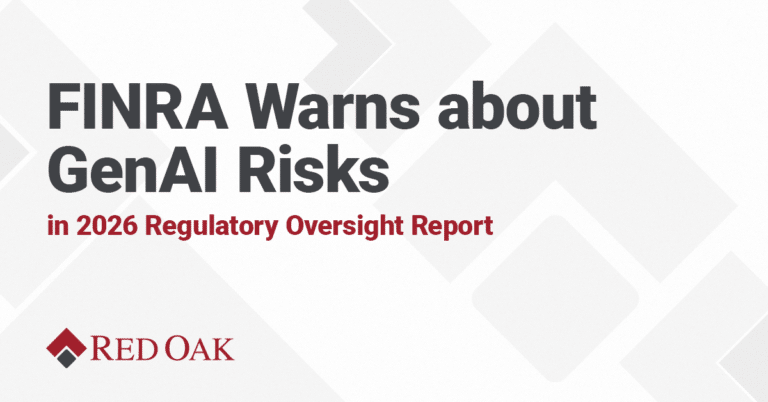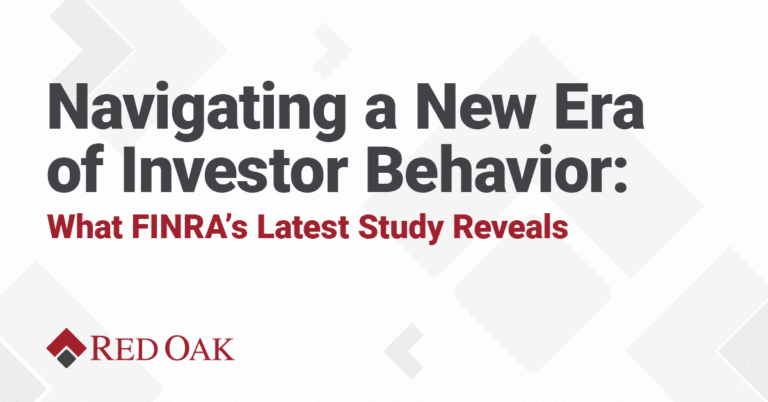Overview
Listen
An article titled “Common AI Pitfalls in the Financial Compliance Industry,” discusses the growing role of Artificial Intelligence in financial compliance and highlights potential challenges firms face when implementing AI solutions. It emphasizes that effective AI integration requires a strong focus on existing workflows, as many vendors prioritize technology over practical application, leading to inefficient systems. The article also points out difficulties with AI models trained on single-company data, which often lack the flexibility to adapt to diverse organizational needs without extensive and time-consuming retraining. Finally, it introduces Red Oak's AI Review module as an alternative, stressing its workflow integration, minimal training data requirements, and seamless system compatibility as key advantages in navigating these common pitfalls.
Critical Questions Powered by Red Oak
Transcript
Read the Blog Post
AI’s Expanding Role in Financial Services Compliance
Artificial Intelligence (AI) is shaking up industries everywhere, with purveyors of the tech promising that their particular flavor of AI-powered will make everything quicker, easier, cheaper, higher quality, less risky, better performing, or some combination thereof. The financial compliance space is no exception. We talk to firms all the time that are anxious to use AI to boost the speed, accuracy, and scalability of their compliance processes. This end-goal isn’t just about efficiency— it’s about keeping up with constantly changing regulations while keeping costs down. But here’s the catch: too many compliance vendors are all about the AI tech and not enough about the compliance process itself. That’s where Red Oak sets itself apart, applying a proven AI approach to the world’s most configurable advertising review workflow engine.
Sacrificing Workflow for AI: A Common Pitfall
Financial firms stand to benefit enormously from well-designed and executed AI review tools. In fact, AI is already making waves by automating time-consuming tasks like document reviews, fraud detection, and compliance reporting. These tools, especially those using Natural Language Processing (NLP), can scan documents for regulatory issues, flagging anything that looks off for human review. Some of these systems even “learn” from past data, getting better at spotting risks over time.
But not all AI solutions are created equal. A big mistake a lot of companies make is putting all the focus on the AI technology and ignoring the importance of workflow. Compliance is a complex process that needs structured steps to review and approve materials across different teams. If the AI isn’t integrated into a strong workflow, it can only take you so far.
Some AI vendors spend so much time talking about their sophisticated models that they forget to think about how those models fit into a company’s existing workflows. The result? Fancy AI features that look good on paper but don’t actually make the day-to-day easier. At the end of the day, compliance isn’t just about smart AI; it’s about making sure that AI works within a framework that’s flexible and tailored to the specific needs of each firm.
The Challenge of One-Company Training Models
Another major challenge with AI compliance tools arises when models are trained on data from just one company. While this might work well for that specific firm, trying to apply the same model to another company with different compliance needs is a recipe for frustration. Each firm has its own unique regulatory and compliance requirements, and using a model built on someone else’s data can lead to errors and inefficiencies.
Retraining these models to fit new firms isn’t simple, either. It often requires hundreds or thousands of documents to adapt the AI, which is both time-consuming and resource heavy. Most firms don’t have the bandwidth to supply that much data or the patience to wait for the retraining process, making these solutions difficult to scale across different organizations.
There’s also the risk of over-complicating the system. Constantly retraining models can introduce bias or inaccuracies, increasing the chance of errors. In compliance, even small mistakes can have significant consequences, both financially and reputationally. A more flexible approach, like using AI that doesn’t need extensive retraining, offers a faster, more adaptable solution that fits different firms' needs without the headaches.
The Risk of Third-Party Workflow Engines
There’s another potential roadblock—third-party workflow engines. Some AI vendors use them, but they’re often limited in flexibility. If the workflow engine can’t adapt to a firm’s unique structure and approval processes, it can cause delays, frustration, and even put the firm at regulatory risk. Some vendors white label these third-party engines, which may work for basic tasks but don’t hold up when things get complicated. Compliance teams have to manage multiple layers of approvals, coordinate across departments, and handle different types of submissions. That’s why a flexible, scalable workflow engine is critical.
Red Oak’s Different Approach
Red Oak is taking a different route with its AI Review module. Unlike competitors who build custom models based on past submissions, Red Oak uses large language models (LLMs) and prompt engineering to offer fast, AI-driven feedback on marketing materials.
Here’s why that matters:
1. Workflow Integration
Red Oak’s strength lies in how it integrates AI into a flexible workflow engine. If AI doesn’t work well within existing workflows, it’s not much help. Red Oak makes sure AI works smoothly alongside your compliance process, helping route documents to the right
reviewers without creating bottlenecks.
2. No Need for Extensive Training Data
Red Oak’s AI Review module doesn’t require thousands of documents to get started. Competitors often need massive data sets to train their AI, which slows things down. Red Oak’s system uses prompt engineering to quickly adapt to new clients, cutting down on setup time and complexity. This makes our solution fast, agile, and easy to implement.
3. Seamless Integration with Other Systems
Whether you’re using your own instance of a large language model (like OpenAI’s ChatGPT or Anthropic’s Claude) or Red Oak’s version, the AI Review module integrates seamlessly. This flexibility lets firms use the technology ecosystem that works best for them.
4. Fast Feedback for Submitters
Submitters can get faster feedback on problematic language before their documents even reach human reviewers. The AI flags things like misleading language, giving submitters a chance to fix it up front. This makes the whole review process faster and more efficient.
Looking Ahead: AI’s Future in Compliance
Red Oak’s AI Review module is still in beta, with a wider launch planned for late 2024. But even in its early stages, it’s clear that Red Oak is positioning itself as a leader in AI-driven compliance. As AI continues to evolve, the firms that succeed will be those that understand it’s about having the right tech that fits into your unique processes. Red Oak’s approach, with its focus on flexibility and adaptability, is setting the stage for the future of compliance.



